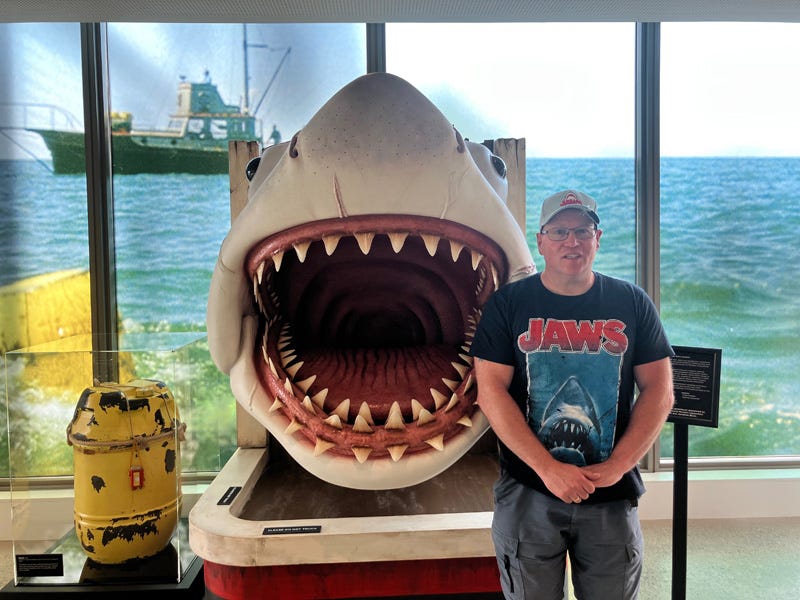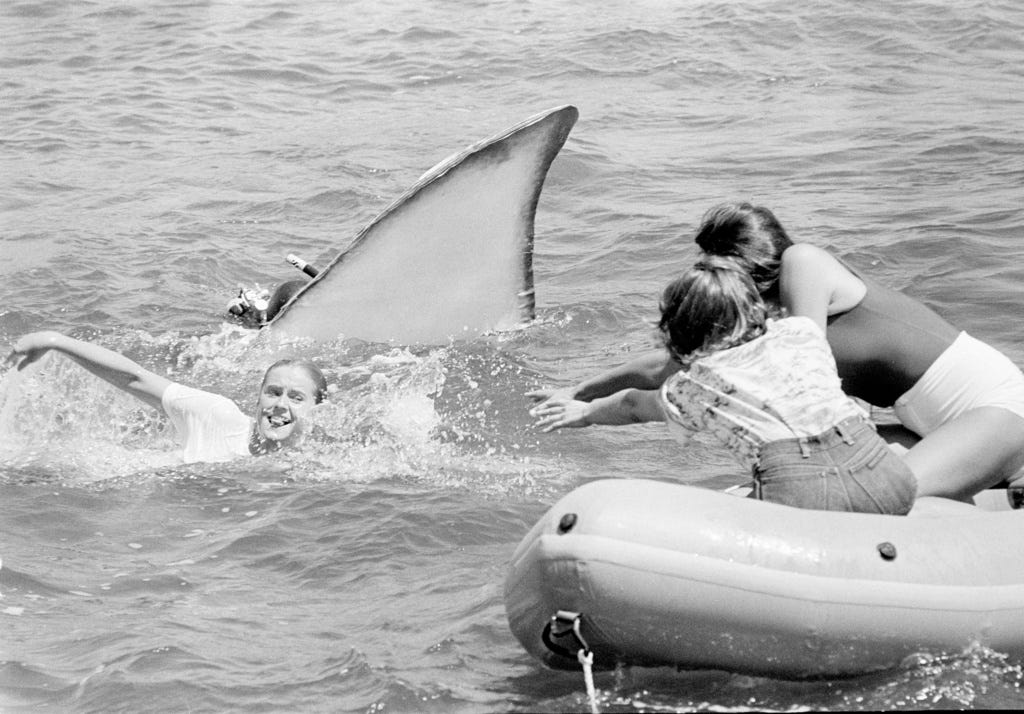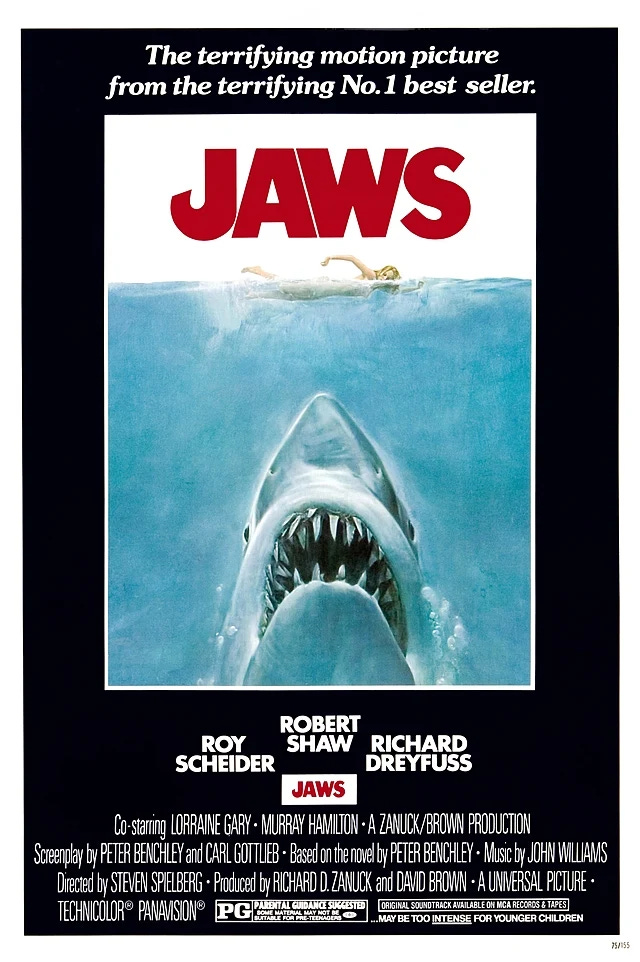"Jaws" at 50: why it is still relevant in this age of anxiety
Fidel Castro called it a “splendid Marxist lesson,” audiences made it a blockbuster and a cultural referent that still gives us chills, but there’s more about this tale that makes it relevant today.

“It was 1975, and Fidel Castro was reading Jaws.”
When I heard that beautifully complex sentence from Wendy Benchley, the widow of Peter Benchley, the author of the best selling novel which would inspire the Hollywood blockbuster that today celebrates the 50th anniversary of its release in theaters, I knew I wanted to write about it. I had never heard the idea of Jaws as a Marxist critique of American capitalism. It’s an idea that is both perfectly profound and perfectly ridiculous, and that’s what grabbed me.
And it is also just a simple declarative sentence that captures the deeper, hidden currents of fear and anxiety that run through the film. They are what makes it a classic. I was 12 years old when Jaws premiered in 1975 and I can guarantee I was not searching for an allegorical, Marxist interpretation. I was just as delightfully horrified as every other kid when it came to hearing two simple notes that signalled the shark was near.
Dun, dun.
Those two notes first coming slowly and then with greater speed and intensity are really all you had to share back then to get family and friends who you were with at the beach to freak themselves out about the possibility of a murderous Great White hunting the shoreline. And even today those two notes still evoke fear of something unknown lurking just beneath the surface.
I had the great pleasure of meeting Wendy Benchley when she came to Martha’s Vineyard last month. We had dinner together in the home of Rose Styron, the poet and human rights activist who is also the widow of the acclaimed novelist William Styron. In Rose’s home, the walls and book shelves are curated with black-and-white memories of the late 1960s and early 1970s and the two women remember well the summer of ‘74 when Jaws was filmed on the Island.
It was a perfect stage set to spend an evening reflecting on the meaning of Jaws at 50. And we discussed in detail how the year 1975, a year of economic anxiety and political malaise, seemed to have many echoes to this current year.
Our dinner took place on Rose’s porch overlooking the Vineyard Haven harbor on a beautiful evening in late May, a very brief calm here on the Island just before the usual storm of activity of the summer. The pressure thrust upon this small island where the population suddenly surges by a factor of five as summer residents and holiday travelers show up, is of course very well captured in the film. As you might remember, the movie was filmed on Martha’s Vineyard and is set in the fictional town of Amity Island as it braces for the 4th of July.
Against a backdrop of a local, year-round population of Islanders serving eager tourists, the stage is set for the tensions that rise when a 25-foot Great White shark starts lurking just off the beaches with that ominous soundtrack.
In the summer of 1974 the film was shot by the then upstart and now legendary director Steven Spielberg. When it premiered the following summer, it was an immediate blockbuster, serving packed theaters and grossing $260 million in the US and nearly $500 million worldwide, which was a record at the time.
We have all learned a lot since then about the true nature of sharks and the irrational fear they can produce. Still that signature soundtrack is there, and the foreboding it creates is very real. So what was it about the Hollywood blockbuster Jaws that so caught the attention of movie goers back then? Although the shark in the movie wasn’t real, but a mechanized one fabricated by Spielberg and given the name Bruce, I can remember the pervasive sense of fear in the air that the film seemed to capture.
In 1975 America, there was much more than just a mechanical shark lurking beneath the surface. There was an age of uncertainty bubbling up at the bitter end of the war in Vietnam and the political violence and corruption that culminated in the Watergate hearings and the historic resignation of President Richard Nixon the summer before. There was rising inflation, surging gas prices and a shift in the global economy that was impacting just about every home. Terrorism was defining the era with active campaigns by the Provisional Irish Republican Army (IRA,) the Palestine Liberation Organization (PLO,) and the militant Marxists of the Weather Underground. There was campus unrest and a time of deep political division. Sound at all familiar?
“There certainly are comparisons worth pondering” between the year 1975 and 2025,” as Wendy Benchley put it.
But another difference she wanted to discuss was between the book and the movie. If you read the book, the storyline takes on a different tack. You quickly are introduced to the idea that there are hidden forces behind the Island’s tanned power broker and mayor of Amity known as Vaughn, who keeps a tight control over the Island. It was Vaughn, as it turns out, who was forcing the initially acquiescent police chief, Martin Brody, to keep the beaches open so that the cash registers would keep ringing from the summer crowd. Vaughn, we learn in the book, was entangled with the Mafia, an interesting plot twist for a book that came out just between the two enormous Hollywood successes of Godfather I and II, the second premiering just months before Jaws.
So here is where Castro might have taken the more keen interest, and it is definitely a very interesting sub plot to the book that the forces of capitalism – or just good old fashioned greed - set up the plot for the chief to delay in reporting the first shark attack, which of course precedes the series of bloody attacks that will follow. And it is the greed of the mafia that pushes Vaughan to convince the chief to delay closing the beaches, resulting in a young boy with a yellow raft being devoured on the shoreline with his mother left to try to find him amid a blood-dimmed tide cluttered with the shredded pieces of the raft.
So how did Wendy know about Castro’s interpretation of the film as the shark representing the voracious jaws of capitalism? Wendy said that a close friend, Frank Mankiewicz, a former aide to Bobby Kennedy, had been in Cuba and saw Fidel Castro with a copy of Jaws in his hands. Wendy remembers that Castro told Frank that the book spoke to him specifically because it captured the way capitalism destroys communities through its “moral decrepitude.”
As Wendy writes on her website, “At a time of change and uncertainty, “Jaws” functioned as an allegory for whatever scared or angered the reader. Even Fidel Castro was a fan, describing “Jaws” as a “splendid Marxist lesson,” one that proved that “capitalism will risk even human life in order to keep the markets going.”
This in many ways is the unique power of the story of Jaws that the shark can come to symbolize whatever it is that we fear most. In Hollywood, I can assure you, the Marxist critique was not what turned this film into a blockbuster. The producer for Universal Pictures Richard Zanuck was clear about that, as Peter Benchley notes in the introduction. He shares that Zanuck told him, “This picture is going to be an A-to-Z adventure story, a straight line, so we want you to take out all that mafia stuff, all the stuff that’ll just be distracting.”
I’m sure it will come as no surprise that the producer’s wishes were granted, and that movie did indeed set new records for profitability in the film industry and in some ways set the standard for how to develop and market a blockbuster.

So what about the comparison between 1975 and today? Who is going to make a new movie about the fear we all sense beneath the surface, what streaming series already does that? Wendy, Rose and I and other dinner guests had some fun discussing that. But what struck me the most was an observation, which I believe came from Rose, that the difference between Jaws and what we are watching unfold these days is that the community ultimately did come together.
Three brave souls - Chief Brody, a salty fisherman named Quint and a marine scientist from the Woods Hole Oceanographic Institute named Hooper – set out in a weathered fishing boat named the Orca to slay the killer shark and save the day. Quint is devoured by the shark but Brody and Hooper close out the movie clinging to a piece of the boat and making their way to shore as the sun sets and the Island can get back to enjoying its summer.
Man, given the leviathan of problems we face these days, we really could use a chief Brody, Captain Quint, and a science geek like Hooper. And, oh yeah, we’re gonna need a bigger boat.
Charles M. Sennott is the publisher of the Martha’s Vineyard Times.




Been waiting for this one!